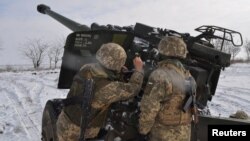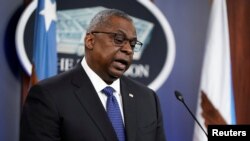France has announced plans to send hundreds of troops to Romania a day after the United States said it would soon move a small number of U.S. troops to Eastern European and NATO countries as fears continue to mount that a Russian troop buildup near Ukraine's borders could be a prelude to an invasion.
French Defense Minister Florence Parly said on January 29 that Paris plans to send "several hundred men" to Romania as part of a "defensive alliance." She also said she had visited Romania on January 27 to discuss the issue.
Speaking with France Inter radio, Parly described Romania as a "high tension zone" that had to be "reassured." Romania shares a border with Ukraine as well as Moldova, where Russia has troops in the breakaway region of Transdniester.
U.S. President Joe Biden said on January 28 that he would move U.S. troops to Eastern Europe and the NATO countries "in the near term." He did not specify where the troops would be sent from or which country they would be sent to. The United States already has tens of thousands of troops stationed across Western Europe.
The Pentagon earlier this week placed about 8,500 U.S. troops on standby for possible deployment to Europe amid Moscow's military buildup, which has moved more than 100,000 Russian troops to regions north, east, and south of Ukraine’s borders.
U.S. Defense Secretary Lloyd Austin said earlier that Russian President Vladimir Putin has all the military capabilities ready to act against Ukraine and it now comes down to a political decision on what action Moscow will take.
"While we don't believe that President Putin has made a final decision to use these forces against Ukraine, he clearly now has that capability," Austin told reporters.
He said there are multiple options available, “including the seizure of cities and significant territories, but also coercive acts and provocative political acts like the recognition of breakaway territories."
Western leaders have scrambled to defuse the crisis caused by the Russian troop buildup by holding talks with Russian diplomats, while trying to put pressure on Putin by vowing unprecedented sanctions should Russia invade.
An ongoing diplomatic effort is set to continue in the coming weeks. French Foreign Minister Jean-Yves Le Drian said on January 29 that he and German Foreign Minister Annalena Baerbock would visit Ukraine on February 7-8. He said he had reassured Ukrainian Foreign Minister Dmytro Kuleba "of our full backing and solidarity with Ukraine."
Kuleba issued a call for the West to remain "vigilant and firm in contacts with the Russian side" in his conversation with Le Drian.
Putin and French President Emmanuel Macron spoke by phone for more than an hour on January 28 and agreed on the need for de-escalation.
According to a Macron aide quoted by the AFP news agency, Putin told Macron that he had "no offensive plans."
U.S. Ambassador to Moscow John Sullivan said on January 28 that Washington was awaiting Russia's response to its written proposals for a diplomatic path out of the Ukraine crisis, voicing hope that a meeting between American and Russian diplomats could then follow.
The Kremlin has said Russia would study the written responses submitted by the United States and NATO concerning Moscow's demands on security guarantees and will then “decide on further actions."
Russia is demanding a major restructuring of Europe’s security architecture in exchange for a de-escalation of the crisis over Ukraine. The United States and NATO have largely rejected the demands, including the call to permanently shut the door on membership for Ukraine and other former Soviet republics.















